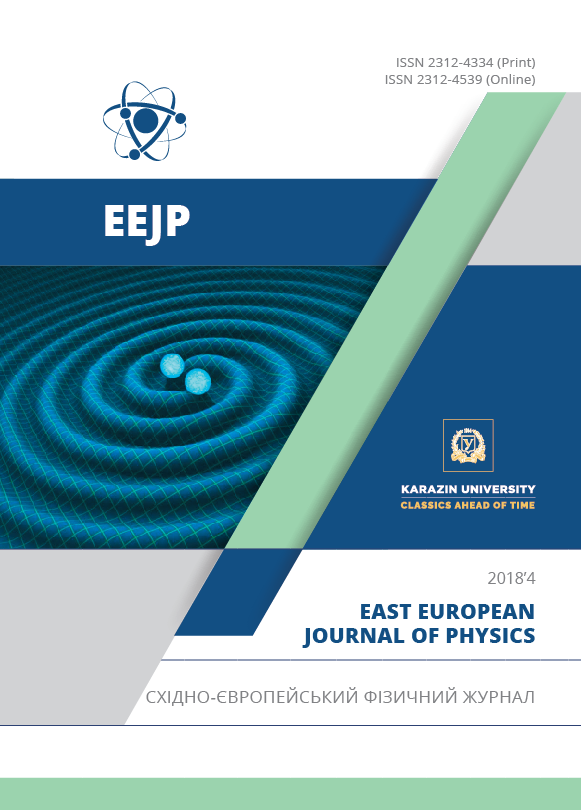Напрацювання ізотопів 11C и 18F. Отримання радіофармпрепарату «Глюкоза 11C».
Анотація
Узагальнено результати напрацювання фотоядерним способом ізотопів 11С та 18F в різних мішенях-матрицях. Дослідження виконані на лінійних прискорювачах електронів НДК "Прискорювач" ННЦ ХФТІ НАН України в діапазоні енергій 10 -40 МеВ для з'ясування можливостей отримання максимально досяжних рівнів активності ізотопів 11С та 18F з метою планування подальших розробок зі створення на основі цих ізотопів радіофармпрепаратів (РФП) для ядерної медицини. В рамках вищевикладеного підходу нами проведені вимірювання рівнів активності ізотопу 18F, що переходить в навколишнє водне середовище при опроміненні мішеней-матриць з фторопласту (С2F4) потоком гальмівного випромінювання. Вихід ізотопу 18F у водне середовище в найсприятливіших умовах (по енергії та середньому струмі пучка) склав 3,6% від величини активності матриці - 40 МБк/г, що є досить низьким показником. Незважаючи на обнадійливе значення питомої активності ізотопу 18F в мішенях-матрицях фториду літію (LiF) -77 МБк/г та плавикової кислоти (НF) - близькою до 100 МБк/г, питання вилучення ізотопу 18F з матриць С2F4, LiF і НF для приготування на його основі РФП залишається відкритим і ставить під сумнів доцільність такої методології напрацювання ізотопу 18F для подальшого використання. Більш результативним виявилось напрацювання ізотопу 11С в опроміненій мішені-матриці стандартної лікарської форми "глюкози моногідрат" (глюкоза). Показано, що в результаті опромінення глюкози пучком гамма-квантів вдається здійснити «мічення» глюкози ізотопом 11С, який утворюється в результаті фотоядерної реакції 12С (γ, n) 11C на ядрі 12С, що входить до складу молекули глюкози - C6H12O6 ×H2O. Опромінений зразок глюкози, розчинений в заданому обсязі розчинника (дистильованої води) буде готовим до використання РФП «Глюкоза, 11C». Показано, що «фотоядерний метод» забезпечує отримання РФП «Глюкоза, 11C» з повною активністю, необхідною для проведення ПЕТ діагностики. РФП «Глюкоза, 11C» до моменту його використання має 100% радіонуклідну чистоту. РФП «Глюкоза, 11C» таким способом отриманий вперше. Обговорюється вибір оптимальної конструкції водоохолоджуваного мішеневого пристрою, що забезпечує щадний (в сенсі теплових навантажень) режим опромінення капсули, заповненої таблетками глюкози. Використовуючи програму «SolidWorks FlowSimulation 2011», розраховані кількісні характеристики швидкостей потоків води, що обтікають капсулу з глюкозою і конвертер.
Завантаження
Посилання
S.N. Dmitriyev, N.G. Zaytseva. Physics of Elementary Particles and Atomic Nuclei. 27(4), 977-1042 (1996). (in Russian)
G.L. Bochek, A.N. Dovbnya and A.S. Zadvorny. Problems of Atomic Science and Technology. 1(33), 66-67 (1999). (in Russian)
N.P. Dikiy, A.N. Dovbnya, Yu.V. Lyashko, E.P. Medvedeva, Yu.D. Tur and V.L. Uvarov, Problems of Atomic Science and Technology. 2(36), 58-61 (2000).
A.N. Dovbnya, N.P. Dikiy, O.V. Nemashkalo, A.I. Tutubalin, V.L. Uvarov, A.G. Shepelev, B.I. Shramenko and L.D. Yurchenko, The Journal of V.N. Karazin Kharkov national University. 619(1), 58-64 (2004). (in Russian)
N.P. Dikiy, A.N. Dovbnya, N.A. Skakun, V.L. Uvarov, M.A. Khazhmuradov and B.I. Shramenko, Problems of Atomic Science and Technology. 1(37), 26-35 (2001).
N.P. Dikiy, A.N. Dovbnya and V.L. Uvarov, Problems of Atomic Science and Technology. 1(42), 168-171 (2004).
A.A. Veryovkin, N.G. Stervoedov, G.P. Kovtun, The Journal of V.N. Karazin Kharkov national University. 746(4), 54-64 (2006). (in Russian)
R.G. Bennett, J.D. Christian, D.A. Petti, W.K. Terry and S.B. Grover, Nuclear technology. 126(1), 102-121 (1999).
A.I. Azarov, A.N. Dovbnya, M.A. Dolzhec, V.A. Kushnir, V.V. Mitrochenko, S.A. Perezhogin, L.I. Selivanov, V.A. Tereshchenko, V.U. Titov, D.V. Titov, V.A. Shevchenko and B.I. Shramenko, Problems of Atomic Science and Technology. 6, 133-136 (2017).
A.N. Dovbnya, B.I. Shramenko. Patent of Ukraine No 28463/3A/18 (27 November 2018). (in Ukrainian)
P. Herrero, C.J. Weinheimer, C. Dence, W.F. Oellerich and R.J. Gropler, J. Nucl. Cardiol. 9, 5-14 (2002).
P. Herrero, T.L. Sharp, C. Dence, B.M. Haraden and R.J. Gropler, J. Nucl. Med. 43, 1530 -1541 (2002).
https://www.solidworks.com/product/solidworks-flow-simulation
V. Piltingsrud, R. Hoops, Med. Phys. 14(3), (1987).
Цитування
Computer Simulation of the Angular Distribution of Electrons and Bremsstrahlung Photons in Tantalum Converter
(2020) East European Journal of Physics
Crossref
Автори, які публікуються у цьому журналі, погоджуються з наступними умовами:
- Автори залишають за собою право на авторство своєї роботи та передають журналу право першої публікації цієї роботи на умовах ліцензії Creative Commons Attribution License, котра дозволяє іншим особам вільно розповсюджувати опубліковану роботу з обов'язковим посиланням на авторів оригінальної роботи та першу публікацію роботи у цьому журналі.
- Автори мають право укладати самостійні додаткові угоди щодо неексклюзивного розповсюдження роботи у тому вигляді, в якому вона була опублікована цим журналом (наприклад, розміщувати роботу в електронному сховищі установи або публікувати у складі монографії), за умови збереження посилання на першу публікацію роботи у цьому журналі.
- Політика журналу дозволяє і заохочує розміщення авторами в мережі Інтернет (наприклад, у сховищах установ або на особистих веб-сайтах) рукопису роботи, як до подання цього рукопису до редакції, так і під час його редакційного опрацювання, оскільки це сприяє виникненню продуктивної наукової дискусії та позитивно позначається на оперативності та динаміці цитування опублікованої роботи (див. The Effect of Open Access).








